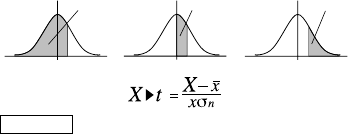
E-49
Distr Sub-menu (11(STAT)7(Distr))
1 P( 2 Q( 3 R( 4 '
t
This menu can be used to calculate the probability of standard normal
distribution. Normalized variate t is calculated with the expression
shown below, using the mean value (o) and population standard
deviation value (xσn) obtained from the data input on the STAT editor
screen.
Standard Normal Distribution
Appendix Single-variable Statistical Calculation
<#053> Select single-variable (1-VAR) and input the following data:
{1, 2, 3, 4, 5, 6, 7, 8, 9, 10} (FREQ: ON)
<#054> Edit the data to the following, using insert and delete:
{0, 1, 2, 3, 4, 5, 6, 7, 9, 10} (FREQ: ON)
<#055> Edit the FREQ data to the following:
{1, 2, 1, 2, 2, 2, 3, 4, 2, 1} (FREQ: ON)
• Examples <#056> through <#059> all use the same data as
Example <#055>.
<#056> Calculate sum of squares of the sample data and sum of
the sample data.
<#057> Calculate number of samples, mean, and population
standard deviation.
<#058> Calculate minimum value and maximum value.
<#059> Performing standard normal distribution approximation on
the input sample data (from Example <#055>) produces
the probabilities shown below.
Distribution probability that is a value less than the
normalized variate when the sample value is 3 (P value for
normalized variate when X = 3)
Distribution probability that is a value greater than the
normalized variate when the sample value is 7 (R value for
normalized variate when X = 7)
P
(t)Q
(t)R
(t)
0 t 0 t 0 t


















